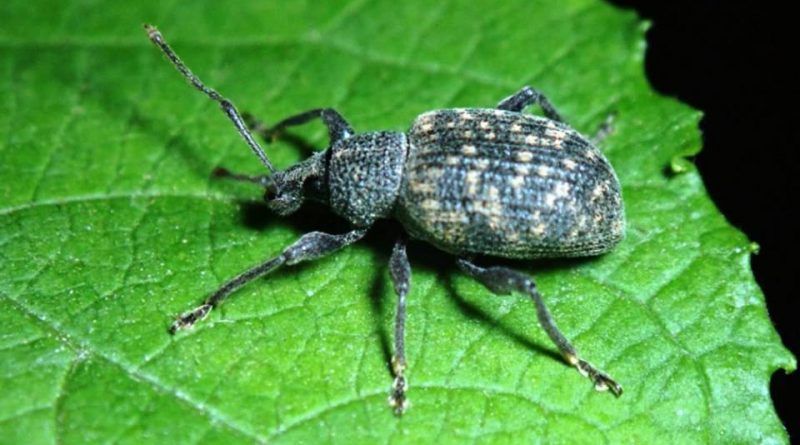Otiorhynchus sulcatus
Otiorhynchus sulcatus
The vine weevil (Otiorhynchus sulcatus, Fabricius 1775) is a beetle belonging to the Curculionidae family.
Systematics –
From a systematic point of view it belongs to:
Eukaryota Domain,
Kingdom Animalia,
Sub-kingdom Eumetazoa,
Bilateria branch,
Phylum Arthropoda,
Subphylum Tracheata,
Superclass Hexapoda,
Insecta class,
Subclass Pterygota,
Endopterygota cohort,
Superorder Oligoneoptera,
Coleopteroid section,
Order Coleoptera,
Suborder Polyphaga,
Infraorder Cucujiformia,
Curculionoidea superfamily,
Curculionidae family,
Entiminae subfamily,
Otiorhynchini tribe,
Genus Otiorhynchus,
Species O. sulcatus.
Geographic Distribution and Habitat –
Otiorhynchus sulcatus is a beetle present in most of the globe, native to the Palearctic region; lives at the expense of plants such as: grapevine, strawberry, rhododendron, azalea, laurel, juniper, holly, etc.
Morphology –
The Otiorhynchus sulcatus, in the adult stage, is 8-10 mm long.
It has a shiny body and wings with grooves covered with yellowish hairs.
The larvae are 8-10 mm long, are light brown in color with a reddish-brown head and with an arched C-shape, fleshy, apodic and with a pale red sclerified head.
Attitude and Life Cycle –
The female of vine weevil lays her eggs around the roots of the host plants.
During her life, the female lays up to 1000 eggs in separate groups around the roots of host plants.
After a few days from the hatching of the eggs, the larvae come out and feed on the roots for many months. These then pupate in a maximum of 20 days. The adults that emerge get nourishment from the leaves and shoots and live no more than 100 days.
The adult, on the other hand, damages the leaves by attacking the ends and causing more substantial damage than those caused by the larvae that feed on the roots.
Ecological Role –
The fight against Otiorhynchus sulcatus must be done taking into account the biological cycle of the insect and was once carried out mainly with geo-insecticides to control the larvae, and with foliar spraying for adults.
However, the fight against this insect begins with a good agroecological organization of crops, decreasing specializations, increasing associations and instead avoiding the use of insecticides that destabilize the agro-ecosystem even more.
Furthermore, the alternative use of containment of this insect through entomopathogenic nematodes is important.
Entomopathogenic nematodes are obligate parasites of the larvae and are useful both against beetles (oziorrinco) and against the larvae of lepidoptera, diptera and hymenoptera. These insects, in the larval stages, live in the ground or in humid areas, such as the tunnels they dig in plants.
For the biological defense against oziorrinco there are two best times to carry out the treatment. Spring, acting on wintering larvae, and in midsummer on young larvae, even easier to eliminate.
Nematodes are marketed by special companies that distribute them in refrigerated polystyrene containers, in order to guarantee the survival of the macro-organism, which does not resist excessive temperatures.
Furthermore, the treatment must be carried out in the cool hours of the day, as the nematodes must have time to penetrate the earth. Otherwise, heat and sun exposure severely limit its effectiveness.
By always keeping the soil well moist, then, the nematodes can survive even for 2 weeks, prolonging their action.
Other agronomic techniques to limit the damage of the oziorrinco can be aimed at adults. In this case, in the evening you can operate by beating the leaves and manual removal. The oziorrinco is very resistant, but has little mobility, so it is easy to catch. Once taken, it can be eliminated by fire, respecting the safety conditions.
Furthermore, in the presence of infestations in previous years, it is advisable to carefully eliminate the vegetation residues of the affected plants, especially the root systems. In the middle of winter, opening the soil with a deep digging process, the overwintering larvae are exposed to the intense cold they cannot survive. Instead, leaving the soil protected and compact in the surface layers, the natural biological cycle of the oziorrinco is favored.
Guido Bissanti
Sources
– Wikipedia, the free encyclopedia.
– Russo G., 1976. Agricultural Entomology. Special Part. Liguori Editore, Naples.
– Tremblay E., 1997. Applied entomology. Liguori Editore, Naples.

